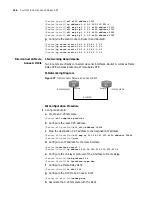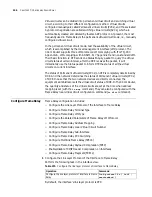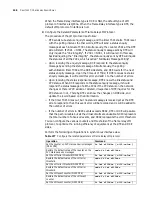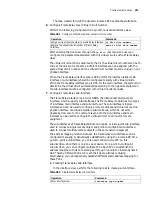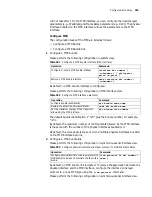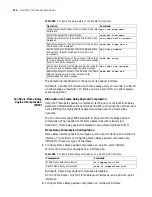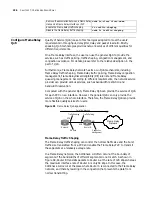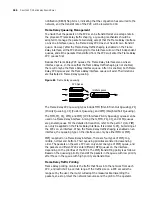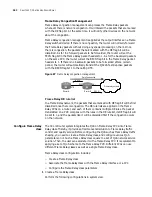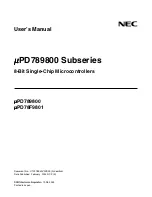
248
C
HAPTER
17: C
ONFIGURING
F
RAME
R
ELAY
When the Frame Relay interface type is DCE or NNI, the default type of LMI
protocol of interface is Q933a. When the Frame Relay interface type is DTE, the
default LMI protocol of interface is null.
4
Configure the Related Parameters of Frame Relay LMI Protocol
The procedure of the LMI protocol is as follow:
■
DTE sends out a status enquiry message, and the timer T391 starts. T391 is set
with the polling interval. In other words, DTE will send a status enquiry
message at each interval of T391. Simultaneously, the counter V391 at the DTE
side will start. If V391 < N391, The status enquiry message sent by DTE will
only inquire the “link integrity”. If V391 = N391, it will clear all. In this case,
besides inquiring the “link integrity”, the status enquiry sent by DTE will inquire
the statuses of all the PVCs, which is called “Full Status Message Polling”.
■
Upon receiving the enquiry message, DCE respond to the status enquiry
message by sending the status message. Simultaneously, the polling
authentication timer T392 at the DCE side starts, and DCE waits for the next
status enquiry message. Upon the timeout of T392, if DCE receives no status
enquiry messages, it will record this error and add 1 to the number of errors.
■
Upon receiving the status response message, DTE knows the link status and
PVC status. When DCE responds to the status enquiry message, it should
respond the status message of all the PVCs if the PVC status on the network
changes or there is PVC added or deleted, irrespective of DTE inquires for the
PVC status or not,. Thereby, DTE can know the changes on DCE side, and
update the record based on that information.
■
If the timer T391 times out, but no status message is received yet at the DTE
side to respond to that, this event error will be recorded and 1 will be added to
the number of errors.
■
If the number of errors in N393 events exceeds N392, DTE or DCE will assume
that the path is usable but all the virtual circuits are unusable. N393 represents
the total number of observed events, and N392 represents the error threshold.
You can configure the various counters and thresholds of the frame relay LMI
protocol, to optimize the running efficiency of equipment at the DTE and DCE
sides.
Perform the following configurations in synchronous interface view.
Table 277
Configure the related parameters of Frame Relay LMI protocol
Operation
Command
Set the counter on PVC status enquiry messages
(N391 DTE)
fr lmi n391dte [
n391-value
]
Restore the default value of the counter on the
PVC status enquiry messages
undo fr lmi-n391dte
Set the LMI error threshold (N392 DCE)
fr lmi n392dce [
n392-value
]
Restore the default value of the LMI error
threshold
undo fr lmi n392dce
Set the LMI error threshold (N392 DTE)
fr lmi n392dte [
n392-value
]
Restore the default value of the LMI error
threshold
undo fr lmi n392dte
Set the LMI event counter (N393 DTE)
fr lmi n393dte [
n393-value
]
Restore the default value of the LMI event
counter
undo fr lmi n393dte
Set the LMI event counter (N393 DCE)
fr lmi n393dce [
n393-value
]
Summary of Contents for 3036
Page 1: ...http www 3com com 3Com Router Configuration Guide Published March 2004 Part No 10014299 ...
Page 4: ...VPN 615 RELIABILITY 665 QOS 681 DIAL UP 721 ...
Page 6: ...2 ABOUT THIS GUIDE ...
Page 7: ...I GETTING STARTED Chapter 1 3Com Router Introduction Chapter 2 3Com Router User Interface ...
Page 8: ...4 ...
Page 16: ...12 CHAPTER 1 3COM ROUTER INTRODUCTION ...
Page 34: ...30 ...
Page 60: ...56 CHAPTER 3 SYSTEM MANAGEMENT ...
Page 98: ...94 CHAPTER 6 DISPLAY AND DEBUGGING TOOLS ...
Page 110: ...106 ...
Page 114: ...110 CHAPTER 8 INTERFACE CONFIGURATION OVERVIEW ...
Page 158: ...154 CHAPTER 10 CONFIGURING WAN INTERFACE ...
Page 168: ...164 ...
Page 188: ...184 CHAPTER 13 CONFIGURING PPPOE CLIENT ...
Page 192: ...188 CHAPTER 14 CONFIGURING SLIP Router ip route static 0 0 0 0 0 0 0 0 10 110 0 1 ...
Page 248: ...244 CHAPTER 16 CONFIGURING LAPB AND X 25 ...
Page 320: ...316 ...
Page 330: ...326 CHAPTER 20 CONFIGURING IP ADDRESS ...
Page 362: ...358 CHAPTER 21 CONFIGURING IP APPLICATION ...
Page 374: ...370 CHAPTER 23 CONFIGURING IP COUNT ...
Page 406: ...402 CHAPTER 25 CONFIGURING DLSW ...
Page 408: ...404 ...
Page 452: ...448 CHAPTER 29 CONFIGURING OSPF ...
Page 482: ...478 CHAPTER 30 CONFIGURING BGP ...
Page 494: ...490 CHAPTER 31 CONFIGURING IP ROUTING POLICY ...
Page 502: ...498 ...
Page 508: ...504 CHAPTER 33 IP MULTICAST ...
Page 514: ...510 CHAPTER 34 CONFIGURING IGMP ...
Page 526: ...522 CHAPTER 36 CONFIGURING PIM SM ...
Page 528: ...524 ...
Page 532: ...528 CHAPTER 37 CONFIGURING TERMINAL ACCESS SECURITY ...
Page 550: ...546 CHAPTER 38 CONFIGURING AAA AND RADIUS PROTOCOL ...
Page 590: ...586 CHAPTER 40 CONFIGURING IPSEC ...
Page 599: ...IX VPN Chapter 42 Configuring VPN Chapter 43 Configuring L2TP Chapter 44 Configuring GRE ...
Page 600: ...596 ...
Page 638: ...634 CHAPTER 43 CONFIGURING L2TP ...
Page 649: ...X RELIABILITY Chapter 45 Configuring a Standby Center Chapter 46 Configuring VRRP ...
Page 650: ...646 ...
Page 666: ...662 ...
Page 670: ...666 CHAPTER 47 QOS OVERVIEW ...
Page 700: ...696 CHAPTER 49 CONGESTION MANAGEMENT ...
Page 706: ...702 CHAPTER 50 CONGESTION AVOIDANCE ...
Page 707: ...XII DIAL UP Chapter 51 Configuring DCC Chapter 52 Configuring Modem ...
Page 708: ...704 ...
Page 762: ...758 CHAPTER 52 CONFIGURING MODEM ...



